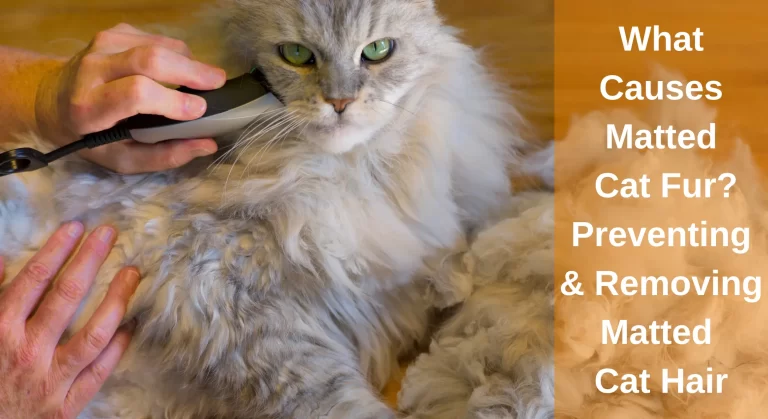How to Bathe a Cat or Kitten? -[Step By Step Guide]
Even though cats are meticulous groomers and can usually take care of their hygiene on their own, however, there are times when a cat bath is necessary. Sometimes, they come into contact with sticky or dirty objects or have a medical condition that calls for frequent medicated shampoo showers.
Although this is the case, the majority of cats respond poorly to bathing, which might be unpleasant for both the cat and the owner.
Bathing a cat can be a daunting task for many pet owners. However, it is essential to keep your feline friend clean and healthy. Choose the right shampoo, prepare the bath area, and get your cat used to water gradually.
If you are wondering how to bathe a cat, then you have come to the right place. Here’s a comprehensive guide that will help you safely and effectively bathe your cat.
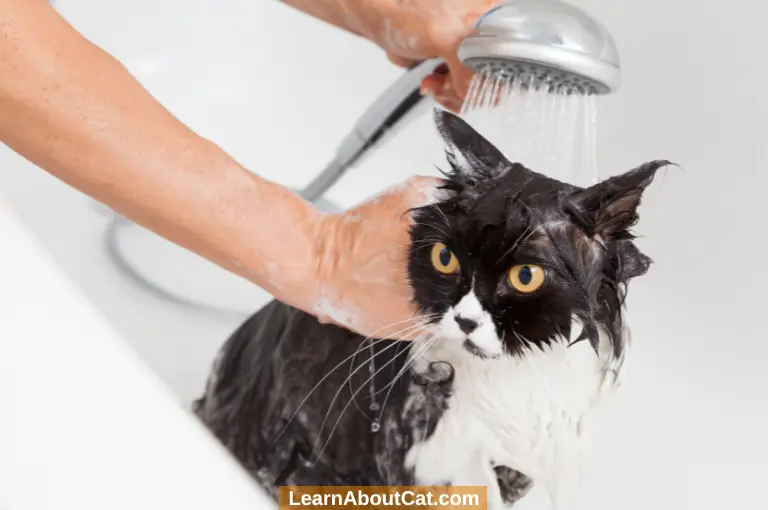
Why Bathing Your Cat is Important
Cats are known for their cleanliness and groom themselves regularly. However, there are instances when cats may require bathing, such as:
- Dirt or debris: If your cat has gotten into something dirty or sticky, a bath can help clean them up.
- Skin conditions: If your cat has a skin condition, your vet may recommend a medicated bath to soothe their skin.
- Fleas or ticks: If your cat has fleas or ticks, a bath can help get rid of them.
Regular bathing can help keep your cat’s fur shiny and healthy, prevent matting, and reduce the number of allergens and dander in your home. Additionally, bathing your cat helps control the amount of hairballs it produces.
It’s important to note that cats are not fond of water, so bathing them can be a challenging experience. However, with the right tools and approach, you can make the process less stressful for both you and your cat.
Steps for Bathing a Cat
1. Before You Begin, Gather the Necessary Tools
Before you start bathing your cat, make sure you have everything you need:
- Cat shampoo: Never use human shampoo on your cat, as it can be harmful to their skin. Make sure you choose a cat shampoo that is gentle and formulated specifically for cats.
- A large cup or pitcher: Use to pour water over your cat during the bath.
- Towels: When your cat is finished bathing, you will need several towels to dry him off.
- Non-Slip Rubber mat: Place a rubber mat in the tub or sink to provide your cat with traction and prevent slips.
- Treats: Be ready to give your cat some treats as a reward for good behavior.
Prepare Your Cat for the Bath
Cats are notorious for disliking water, so preparing your cat for the bath beforehand is important.
- Comb Your Cat’s Fur: Brushing your cat’s fur thoroughly before the bath to remove any tangles or mats is crucial. This will make the bathing process more comfortable for your cat and prevent any mats from worsening when wet.
- You can Cut Your Cat’s Nails if You like: The main purpose is to prevent your skin from getting seriously scratched by your cat. You might want to consider nail clipping if your cat doesn’t spend much time outside. To avoid having your cat link getting their nails clipped with unpleasant experiences, ensure you do it a few days before you wash them.
2. Select Your Action Plan
There are several bathing options available, depending on your circumstance.
The majority of cats are afraid of water sprays; therefore, you may want to think about limiting the strength of your showerhead’s nozzle to the absolute minimum and keeping it very close to your cat’s skin if it is spraying or exerting excessive pressure.

2.1 Decide where to take action
Your sink can be too small for your cat, or the shower head might be too low, causing back pain. A large basin with a portable water source that isn’t too shallow is ideal so, choosing a handheld showerhead rather than a fixed tap is a good idea. Thus, you can use a bathtub or can install a large washbowl in your shower.
2.2 In the Bottom of the Sink or Tub, Place a Rubber Mat
This will make your cat considerably more at ease and prevent her from tripping as she moves about. You may use anything that can be wet but won’t slip in its place if you don’t have a rubber mat, such as a big plastic washbowl, or you can use a cloth that you don’t mind having wet or ruined.
2.3 Choose the Right Soap
Your cat’s skin and coat might suffer greatly if the wrong sort of soap is used on her. Look for a hypoallergenic, fragrance-free soap made specifically for cats. Water can be used to pre-dilute it.
Ideally, you should avoid getting soap in your cat’s eyes while giving it a bath, but it happens accidentally sometimes. Therefore, selecting a soap that won’t sting or irritate the eyes or cause discomfort or itching makes sense.
Also Read: Can I Use Human Shampoo on My Cat?
2.4 Fill the Tub or Sink With Warm Water
The water should be lukewarm or warm enough to be cosy but not scalding. Before allowing your cat into the bathtub, letting the water run for a bit is a good idea. While you try to maintain the appropriate temperature, your cat shouldn’t be in the bathtub.
Fill the tub or sink with 3-4 inches of warm water. Make sure the water temperature is comfortable for your cat.
2.5 Eliminate any Clutter that Might Cause a Hazard
These will probably definitely obstruct your path and complicate your situation. Just keep the items you’ll need on hand, like soap and washcloths.
Even if you want to give your cat a bath in the sink, it would be a good idea to cover or remove the mirror. During this frantic stage, individuals could feel frightened and terrified when they get a peek at themselves in the mirror.
2.6 Close the Bathroom Door
Your cat won’t need to worry about escaping this way. Additionally, a closed door will keep the bathroom warm and shield it from draughts.
3. While Bathing a Cat in a Tub
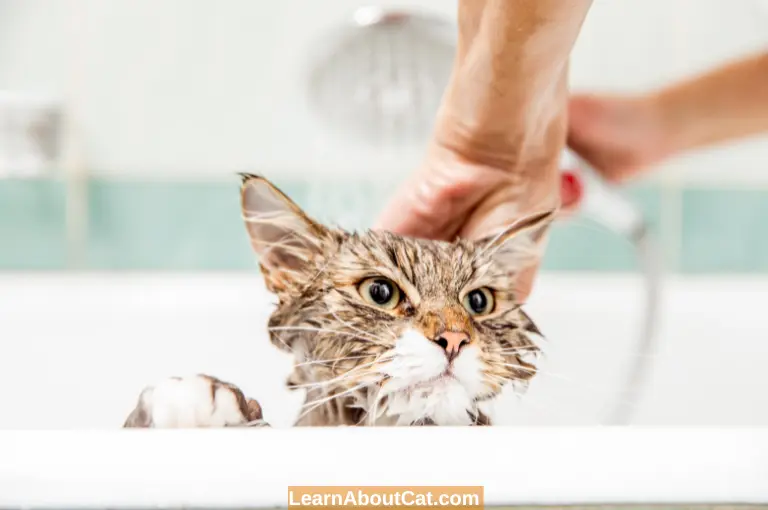
- Wet your cat’s fur: Use a handheld showerhead or a cup to wet your cat’s fur thoroughly. Keep the showerhead close to her body as you descend from her neck, and use a little force. Keep your hands off of your cat’s face and ears.
- Lather your cat’s coat after shutting off the water by giving her a gentle cleaning and brushing your cat as well.
- Apply the shampoo: Apply a small amount of cat shampoo to your cat’s fur, starting from the neck and working your way down. Be careful not to get shampoo in their eyes, ears, or nose.
- Massage the shampoo into your cat’s fur: Use your fingers to massage the shampoo into your cat’s fur, making sure to get all the way down to the skin.
- Do not ever spray or soap your cat’s face. Instead, gently clean it with a wet, soap-free washcloth.
- Rinse thoroughly: Use the showerhead or cup to rinse your cat’s fur thoroughly, making sure to remove all the shampoo.
- Hold onto your cat firmly at all times to prevent them from running away. It could be a good idea to make plans for assistance. Never underestimate the power of food and toys as a distraction and motivation.
- Dry your cat off: Use a towel to dry your cat off, starting with its head and working your way down. Use a separate towel to dry their face.
4. After Taking a Bath
If your cat has short hair, this is all that is necessary. They’ll swiftly use up all of their drying capacity.
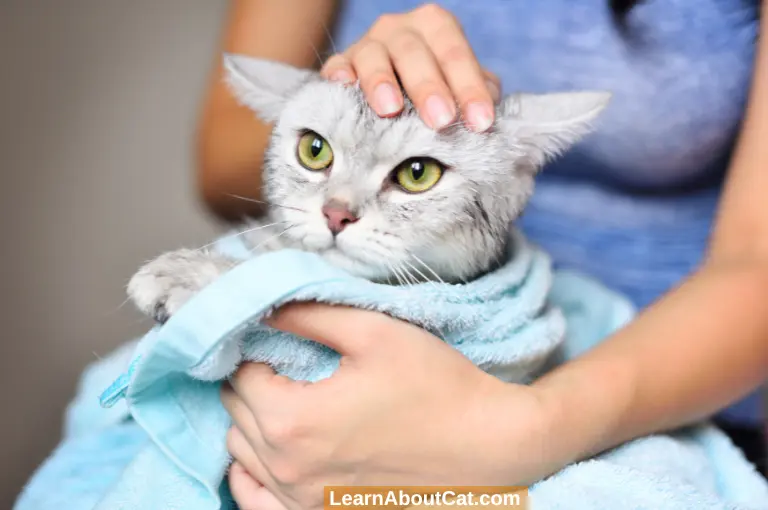
Try to keep them warm for as long as you can so they can dry completely. Ensure you don’t use a hair dryer around your cat, as the noise can cause fear. Instead, let your cat air dry in a warm, dry room. When your cat’s fur is dry, you can comb it with a brush
5. Reward Your Cat
After the bath, reward your cat with treats and praise. Doing this will reinforce positive associations with bath time and make the next bath a little more enjoyable.
How To bathe a Kitten
Given their smaller size and more flexible personalities, kittens may benefit more from the dipping approach of washing. A kitten is easier to wash since it is less independent, and its size and strength make it easier to control.

- Three to four jugs of hot water
- The ideal type of soap
- Towels and cloths
- Treat
- Substitute pitcher
- Substitute brush
Steps of Bathing
- Before putting your cat inside the first container, make sure she is able to stand on her hind legs and hold on to the rims. For your kitten’s size, the containers should be broad but not excessively deep so that her head and neck can safely be above water when standing. While avoiding her face, thoroughly wet her garments.
- She must be removed from the container and placed on a fresh towel. Either softly massage her with soap or gently wipe her with a washcloth already smeared with soap. Instead of washing her face with soap, gently scrub it with a wet cloth. She is now prepared for a brush.
- Put her in the second water container after giving her coat a thorough rinse. Put her in the third container whenever the water starts to smell too soapy, and so on, until she is well-cleaned and soap-free. You could want to moisten her coat with a pitcher or rinse her off under the sink’s water tap.
- Prior to laying your cat down on a dry towel to absorb any residual water, it should be thoroughly cleaned. Dry her completely using as many towels as required. Kittens typically don’t need a hair dryer since their coats dry quickly.
- Give treats both before and after to help your cat develop a good association with bathing and water.
Find Out More About Kitten: When Can Kittens Leave Their Mom?
What Happens if You Bathe Your Cat too Much?
If not always, most cats can avoid taking a bath totally. For the majority of cats, self-grooming and routine brushing will be more than enough because they spend most of their time inside and have short coats. However, based on her health, your cat could need regular bathing.
You shouldn’t take baths more frequently than necessary. The most often that cats should be washed is once per month. Being harshly and frequently washed has several negative effects, as follows.
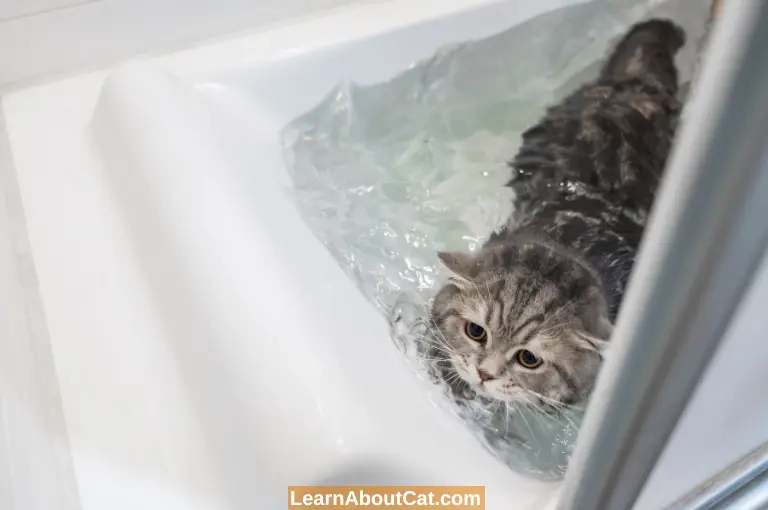
1. Poor Coat Quality
Bathing improves the condition and gloss of the coat and is typically connected to good coat maintenance. The frequent bathing, however, can be detrimental to excellent grooming.
Frequent washing that completely eliminates natural body oils will have an influence on the coat’s condition. Hair loss may also occur if the coat is very dry and loses its luster.
2. Irritated Skin
The severity of this might vary from a little case of dandruff to a more serious illness, like an infection. The results of excessive bathing and over-grooming are the same.
Some of the essential oils that your cat’s skin naturally generates can be lost if you give your cat too many baths or the incorrect sort of soap. Dry, flaky skin that is more prone to irritation, injuries, and even infections will be the outcome.
3. Traumatic Injury
Despite your best attempts to make it fun for them, most cats dislike water and being handled excessively. Because of this, repeatedly subjecting your cat to this unpleasant experience increases the risk of trauma, not to mention the likelihood that, as a result of this terrible experience, they may grow uncomfortable with your touch and handling.
Breeds of Cats That Love The Water
- Turkish Van: The most likely explanation for this is that they don’t experience any discomfort when swimming or just thereafter since their coat is naturally water-resistant. They can spend a lot of time in the water.
- Bengal: The Bengal breed was developed recently, between the 1960s and 1980s, by mating domestic cats with Asian leopard cats. This active breed is renowned for its enjoyment of water play.
- Maine’s Coon: In the past, during protracted sea voyages, Maine Coon cats were utilized as pest control on board ships. Their aptitude for hunting and natural affinity for the sea probably led to their selection for this role.
How often should I bathe my cat?
It is generally recommended to bathe your cat once every 4-6 weeks. However, the frequency of bathing your cat depends on whether or not they have a skin condition or have gotten into something dirty or stinky.
Can I use human shampoo for bathing my cat?
No, A cat should not be bathed with human shampoo. The ingredients in human shampoo are made for human hair, which makes them too harsh for your cat’s sensitive skin. The best shampoo for cats is one designed specifically for them.
What should I do if my cat gets stressed during the bath?
If your cat gets stressed during the bath, try to remain calm and speak to them in a soothing voice. You can also offer treats and praise to help them relax. If your cat continues to be stressed, it may be best to stop the bath and try another time again.
Can I bathe my cat if they have fleas?
Yes, you can bathe your cat if they have fleas. Although, it is imperative to use a flea shampoo that is specifically formulated for cats. Be sure to follow the instructions on the shampoo carefully and consult your veterinarian if you have any concerns.
What cat breed likes to play with water?
Several bobtail breeds include the Norwegian Forest Cat, Turkish Angora, Japanese Bobtail, Highlander, American Bobtail, Manx, Egyptian Mau, Abbysinian, Kurilian Bobtail, Siberian, and Savannah.
Final Thoughts!
If your cat is healthy, active, and solely permitted inside, self-grooming can be enough for their hygienic needs. However, there are some circumstances when cleaning may be essential and in some cases, even necessary regularly, so it’s important to make the procedure as pleasurable as possible for both you and your cat.
Bathing your cat can be a challenging task, but with the right tools, preparation, and patience, you can successfully give your cat a bath without causing too much stress or harm.
Remember to use cat-specific shampoo, prepare your cat beforehand, and reward your cat afterward. By following these steps, you can keep your cat clean and healthy and have a stress-free bathing experience.
Related Posts:
Who is Isabella?
My name is Isabella, and I am a dedicated and knowledgeable cat enthusiast. With years of experience caring for cats and a deep love for felines, I made a mission to help other cat lovers navigate the challenges of cat ownership.





